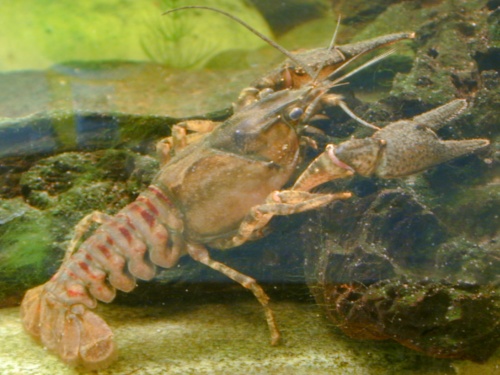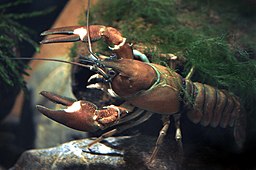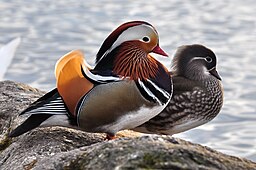 |
Spinycheek crayfish | Status LU: established. 1st record: 1978. |
 |
Gefleckte Flosskriibs, Kamberkriibs | Status Eur.: established. IAS of EU concern (2016). |
 |
Écrevisse américaine | RA: ISEIA: C2. Harmonia+: n/a. |
 |
Kamberkrebs | Wikipedia:     | Wikispecies: n/a (2019) | CABI | Wikispecies: n/a (2019) | CABI |
 |
Gevlekte rivierkreeft | Back to the list of invertebrates |
Contents
Brief description
 Faxonius limosus Rafinesque 1817 (Synonyme Orconectes limosus Rafinesque 1817) is native to the east coast of North America. It is unusual in that it lives in silty streams, rather than the clear water usually preferred by crayfish. Like Pacifastacus leniusculus, another invasive North American crayfish, O. limosus carries crayfish plague and is a threat to native European crayfish. The spinycheek crayfish was introduced to Germany in 1890, and has since spread across much of Northern Europe, recently reaching the United Kingdom. It has also spread southwards as far as the Danube in Serbia. These Crayfish live on the bottom of the freshwater pools, such as lakes, ponds and swamps. They prefer flat, sandy, and rocky floors. They are also found outside the water on beaches or lawns near the pool of water. They use rocks to make burrows while in the water (Wikipedia contributors 2019).
Faxonius limosus Rafinesque 1817 (Synonyme Orconectes limosus Rafinesque 1817) is native to the east coast of North America. It is unusual in that it lives in silty streams, rather than the clear water usually preferred by crayfish. Like Pacifastacus leniusculus, another invasive North American crayfish, O. limosus carries crayfish plague and is a threat to native European crayfish. The spinycheek crayfish was introduced to Germany in 1890, and has since spread across much of Northern Europe, recently reaching the United Kingdom. It has also spread southwards as far as the Danube in Serbia. These Crayfish live on the bottom of the freshwater pools, such as lakes, ponds and swamps. They prefer flat, sandy, and rocky floors. They are also found outside the water on beaches or lawns near the pool of water. They use rocks to make burrows while in the water (Wikipedia contributors 2019).
Faxonius limosus is omnivorous and, being able to reach high densities, can impact native macroinvertebrates and macrophytes (CABI 2019).
IAS of Union concern
In 2016, Faxonius limosus Rafinesque 1817 was added to the list of invasive alien species of Union concern (Anonymous 2016) which implies that member states shall take all necessary steps to prevent it’s unintentional introduction or spread.
Status and distribution in Luxembourg
Records of Faxonius limosus Rafinesque 1817 in Luxembourg. Data source: Recorder-Lux, iNaturalist & GBIF, 2025-12-20.
Faxonius limosus Rafinesque 1817 was first documented in Luxembourg in 1978 in the river Moselle near Wasserbillig, municipality of Mertert (Neitzke 1978 cit. in Dhur & Massard 1995: 144). Atten (1987) located the immigrant in several places in Moselle (Schengen, Remich), Duhr (1993) downstream of Stadtbredimus, in the Remerschen ponds and in the lower reaches of the Sûre (cit. in Duhr & Massard 1995: 144 & 147).
It is no longer possible to eliminate the spinycheek crayfish populations present (Troschel 2010: 202, Troschel & Bartl 1998: 146).
Management
Action plan
An action plan regarding the management of Faxonius limosus (and Pacifastacus leniusculus) has been published in 2020:
→ Finalised Action Plan for Faxonius limosus (De Sousa 2020)
Risk assessment
ISEIA protocol
C2 (1+2+3+1) (Ries et al. 2017: 68).
Harmonia+ protocol
Not assessed yet.
Worldwide distribution

cabi.org: https://www.cabi.org/isc/datasheet/72033#toDistributionMaps
Fact sheet
PDF fact sheet of the Nature and Forestry Administration: FR | DE
Bibliography
- Administration des eaux et forêts, service de la chasse et de la pêche, 1998. Fische in Luxemburg. Kartierung der Fische, Neunaugen und Flußkrebse des Großherzogtums Luxemburg. ISBN 2-495-28004-8. 153 pp.
- Anonymous, 2016. Commission implementing regulation (EU) 2016/1141 of 13 July 2016 adopting a list of invasive alien species of Union concern pursuant to Regulation (EU) No 1143/2014 of the European Parliament and of the Council. Official Journal of the European Union L 189: 4-5.
- Atten, D., 1987. Étude des populations d’Ecrevisses d’eau douce au grand-duché de Luxembourg et spécialement de l’Écrevisse de Californie. Luxembourg, Mémoire sci. asp. prof., 190 pp.
- CABI, 2010. Faxonius limosus (Rafinesque, 1817) [original text by Elena Tricarico]. In: Invasive Species Compendium. Wallingford, UK: CAB International. URL: www.cabi.org/isc [accessed 2019-11-25]
- De Sousa, Tiago, 2020. Plan d’action pour espèces exotiques envahissantes au Grand-Duché de Luxembourg : l’Écrevisse signal, Pacifastacus leniusculus (Dana, 1852) et l’Écrevisse américaine, Faxonius limosus (Rafinesque, 1817). Version 4/09/2020. Administration de la nature et des forêts, Luxembourg. 29 pp.
- Duhr, G., 1993. Étude des espèces d’invertébrés immigrés ou introduites dans la Moselle luxembourgeoise et dans les écosystèmes aquatiques qui en dépendent. Historique et répartition actuelle. Centre univ. Luxemb., Dép. Form. pédag., mém. sci. 213 p.
- Dhur, G. & J.A. Massard, 1995. Étude historique et faunistique des Invertébrés immigrés ou introduits dans la Moselle luxembourgeoise et ses affluents. Bull. Soc. Nat. luxemb. 96: 127-156. [PDF 1896 KB]
- Meisch, C. & J.A. Massard, 2015. Les recherches sur les crustacés (Crustacea) du Luxembourg : aperçu historique. Bull. Soc. Nat. luxemb. 116: 381-390. [Orconectes limosus: p. 282]
- MNHNL, 2000-. Orconectes limosus Rafinesque 1817 in Recorder-Lux, database on the natural heritage of the Grand Duchy of Luxembourg. Musée national d’histoire naturelle, Luxembourg. URL: https://mdata.mnhn.lu [Accessed 2019-11-25]
- MNHNL, iNaturalist & GBIF, 2019. Orconectes limosus Rafinesque 1817 in MNHNL-mdata, online portal combining species observation from Recorder-Lux, iNaturalist and GBIF. National Museum of Natural History, Luxembourg. URL: https://mdata.mnhn.lu [Accessed 2019-11-25]
- Neitzke, C., 1978. Zur Kenntnis des Makrozoobenthons der Mosel: Weichtiere (Mollusca). Wissenschaftliche Hausarbeit zum Staatsexamen für das Lehramt an Gymnasien, Mainz.
- Ries, C., A. Arendt, C. Braunert, S. Christian, A. Dohet, A. Frantz, G. Geimer, M. Hellers, J. A. Massard, X. Mestdagh, R. Proess, N. Schneider & M. Pfeiffenschneider, 2017. Environmental impact assessment and black, watch and alert list classification after the ISEIA Protocol of invertebrates in Luxembourg. Bull. Soc. Nat. luxemb. 119: 63-70. [PDF 360 KB]
- Troschel, H.J., 2010. Les poissons au Luxembourg. Cartographie des poissons, lamproies et écrevisses du grand-duché de Luxembourg. 2e édition. Administration de la gestion de l’eau, Luxembourg. ISBN 978-2-91989-713-1. 223 pp. [Orconectes limosus: p. 202-203]
- Troschel, H.J. & G. Bartl, 1998. Fische in Luxem-burg. Kartierung der Fische, Neunaugen und Flusskrebse des Großherzogtums Luxemburg. Administration des Eaux et Forêts (éd.), Luxembourg, 168 pp. [Orconectes limosus: p. 146-147]
- Wikipedia contributors, 2019. Orconectes limosus in Wikipedia, The Free Encyclopedia, 23 September 2019. URL: https://en.wikipedia.org/wiki/Orconectes_limosus [accessed 2019-11-25]
Page content last updated on 2024-07-31.

























